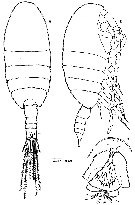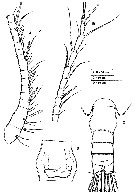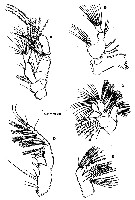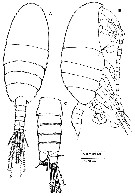|
|
 |
Fiche d'espèce de Copépode |
|
|
Calanoida ( Ordre ) |
|
|
|
Clausocalanoidea ( Superfamille ) |
|
|
|
Stephidae ( Famille ) |
|
|
|
Stephos ( Genre ) |
|
|
| |
Stephos grievae Krsinic, 2015 (F,M) | |
| | | | | | | Ref.: | | | Krsinic, 2015 (p.1, Descr. F, M, figs. F, M, Rem.) |  Issued from : F. Krsinic in Mar. Biodiv. Rec., 2015, 8. [p.3, Fig.1]. Female (from 42°47'42.2''N, 17.5°23'22.3''E): A-B, habitus (dorsal and lateral, respectively); C, rostral area (ventral). Nota: ratio of prosome and urosome as 2.9 : 1. - Rostral area, with 2 sensillae medially, rostrum represented by rounded knob. - Urosome 4 free somites; proportional lengths of urosomites and caudal rami 37.4 : 18.6 : 17 : 13.5 : 13.5 = 100. - Caudal rami symmetrical, 1.25 times longer than wide; ramus with 4 terminal setae corresponding to setae III-VI, seta VII small, pinnate, setae I and II absent
|
 Issued from : F. Krsinic in Mar. Biodiv. Rec., 2015, 8. [p.4, Fig.2]. Female: A, A1 segments 1-15; B, A1 segments 16-24; C, urosome (dorsal); D, genital double-somite (ventral). Nota: Genital double-somite about as long as wide, symmetrical, with proximolateral margins produced in dorsal aspect. External genital area symmetrical in venytral view, paired egg-laying duct, paired gonopores situated medially near posterior edge, covered by single operculum. - A1 symmetrical, 24-segmented, reaching almost to end of 3rd urosomite.
|
 Issued from : F. Krsinic in Mar. Biodiv. Rec., 2015, 8. [p.5, Fig.3]. Female: A, A2; B, Md; C, Mx1; D, Mxp; E, Mx2. Nota: A2 with exopod (7-seggmented) longer than endopod (2-segmented). - Md gnathobase cutting edge with isolated unicuspid tooth, 8 heterogeneous teeth and 1 dorsal spinulose seta. Endopod 2-segmented (1st segment with 4 unequal setae and terminal segment truncate bearing 11 setae). Exopod 5-segmented (setal formula: 1, 1, 1, 1, 2). Mx1 praecoxal arthrite bearing 9 stout marginal spines and 4 elements on posterior surface; coxal epipodite with 9 and coxal endite with 4 setae; proximal basal endite with 3 setae, distal basal endite with 5 setae, basal exite unarmed; exopod bearing 11 setae; endopod articulated to basis, indistinctly 3-segmented, with setal formula 3, 4, 7. - Mx2 praecoxal endites with 6 and 3 setae, respectively; coxal endites each with 3 setae; allobasis with proximal endite powerfully developed with 3 setae, 1 stouter than rest; endopod 3-segmented, with setal formula 1, 1, 4. - Mxp praecoxal endite with 1 seta and row of spinules; syncoxal endites, setal formula 2, 3, 3on medial margin, distal seta thorn-like; distal margin with row of spinules; basis with longitudinal row of spinules and with 3 setae, free endopod 6-segmented, armature formula 2, 4, 4, 3, 3+1, 4.
|
 Issued from : F. Krsinic in Mar. Biodiv., 2015, 8. [p.6, Fig.4]. Female: A, P1; B, P2; C, P3; D, P4; E, P5. Nota: P5 symmetrical, uniramous, 3-segmented, proximal segment separated fom intercoxal sclerite; 3rd segment very long, armed with setules distally along both margin; distal segment armed with single small spine on anterior surface and spiniform process laterally.
|
 Issued from : F. Krsinic in Mar. Biodiv. Rec., 2015, 8. [p.2]. Female and Male : Armature formula in swimming legs P1 to P4.
|
 Issued from : F. Krsinic in Mar. Biodiv. Rec., 2015, 8. [p.7, Fig.5]. Male: A-B, habitus (dorsal and lateral, respectively); C, urosome (dorsal). Nota: Rostral area as in female.
- Prosome: urosome ratio = 2.85: 1.
- Urosome 5 somites; proportional lengths of urosomites 30 : 16.5 : 20 : 18.5 : 15 = 100.
- genital somite slightly asymmetrical viewved dorsally, wider than long; genital aperture located on left side.
Caudal rami as in female.
Armature of A2 and swimming legs P1 to P4 as in female.
|
 Issued from : F. Krsinic in Mar. Biodiv. Rec., 2015, 8. [p.8, Fig.6]. Male: A, A1 segments 1-15; B, A1 segments 16-24; C, right P5; D, E, F, left P5 (F: segments 4 and 5). -P5 uniramous and asymmetrically. Right leg 4-segmented and very long; esgment 2 (basis) longer than coxa, segment 4 very elongate, distal part is more robust than proximal, hook-like distally with thickened knee-shaped projection and inner margin with small denticles. left leg 5-segmented, segments unarmed, segment 2 (basis) elongate and robust, segments 3 and 4 shorter and of similar length, segment 5 crescent -shaped, longer than segment 2, articulated to segment 4 at approximately 1/4 of length of segment, shorter part in form of heavy, tapering processes, while longer part forms a club-shaped curved extension.
| | | | | NZ: | 1 | | |
|
Carte de distribution de Stephos grievae par zones géographiques
|
| | | | | | | Loc: | | | Lenga Pit, Mljet Island (S Adriatic)
Type locality: 42° 47' 42.2'' N, 17.5° 23' 22.3'' E. | | | | N: | 1 | | | | Lg.: | | | (1196)* F: 0, 60-0,67; M: 0,55-0,62.
* : excluding caudal rami. | | | | Rem.: | Lenga Pit (Mljet Island) is about 100 m from the shoreline, there is a small 9 m deep lake at the end of the cave (Salinity in the water column below depths of 3 m is between 21.00 and 39.00, temperature approximately 15.5°C.
For Krsinic (2015, p.5) the species with male P5 is typical of species group IV (see Bradford-Grieve, 1999). | | | Dernière mise à jour : 12/05/2016 | |
|
|
 Toute utilisation de ce site pour une publication sera mentionnée avec la référence suivante : Toute utilisation de ce site pour une publication sera mentionnée avec la référence suivante :
Razouls C., Desreumaux N., Kouwenberg J. et de Bovée F., 2005-2026. - Biodiversité des Copépodes planctoniques marins (morphologie, répartition géographique et données biologiques). Sorbonne Université, CNRS. Disponible sur http://copepodes.obs-banyuls.fr [Accédé le 07 janvier 2026] © copyright 2005-2026 Sorbonne Université, CNRS
|
|
 |
 |









